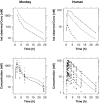Assessment of Interspecies Differences in Drug-Induced QTc Interval Prolongation in Cynomolgus Monkeys, Dogs and Humans
- PMID: 26553352
- PMCID: PMC4689776
- DOI: 10.1007/s11095-015-1760-9
Assessment of Interspecies Differences in Drug-Induced QTc Interval Prolongation in Cynomolgus Monkeys, Dogs and Humans
Abstract
Background and purpose: The selection of the most suitable animal species and subsequent translation of the concentration-effect relationship to humans are critical steps for accurate assessment of the pro-arrhythmic risk of candidate molecules. The objective of this investigation was to assess quantitatively the differences in the QTc prolonging effects of moxifloxacin between cynomolgus monkeys, dogs and humans. The impact of interspecies differences is also illustrated for a new candidate molecule.
Experimental approach: Pharmacokinetic data and ECG recordings from pre-clinical protocols in monkeys and dogs and from a phase I trial in healthy subjects were identified for the purpose of this analysis. A previously established Bayesian model describing the combined effect of heart rate, circadian variation and drug effect on the QT interval was used to describe the pharmacokinetic-pharmacodynamic relationships. The probability of a ≥ 10 ms increase in QT was derived as measure of the pro-arrhythmic effect.
Key results: For moxifloxacin, the concentrations associated with a 50% probability of QT prolongation ≥ 10 ms (Cp50) varied from 20.3 to 6.4 and 2.6 μM in dogs, monkeys and humans, respectively. For NCE05, these values were 0.4 μM vs 2.0 μM for monkeys and humans, respectively.
Conclusions and implications: Our findings reveal significant interspecies differences in the QT-prolonging effect of moxifloxacin. In addition to the dissimilarity in pharmacokinetics across species, it is likely that differences in pharmacodynamics also play an important role. It appears that, regardless of the animal model used, a translation function is needed to predict concentration-effect relationships in humans.
Keywords: PKPD modelling; QT interval prolongation; cardiovascular safety; drug development; interspecies differences.
Figures





Similar articles
-
Pharmacokinetic-pharmacodynamic modelling of the effect of Moxifloxacin on QTc prolongation in telemetered cynomolgus monkeys.J Pharmacol Toxicol Methods. 2011 May-Jun;63(3):304-13. doi: 10.1016/j.vascn.2011.03.002. Epub 2011 Mar 17. J Pharmacol Toxicol Methods. 2011. PMID: 21419854
-
Identifying the translational gap in the evaluation of drug-induced QTc interval prolongation.Br J Clin Pharmacol. 2013 Nov;76(5):708-24. doi: 10.1111/bcp.12082. Br J Clin Pharmacol. 2013. PMID: 23351036 Free PMC article. Clinical Trial.
-
Application of a probabilistic method for the determination of drug-induced QT prolongation in telemetered cynomolgus monkeys: effects of moxifloxacin.J Pharmacol Toxicol Methods. 2007 May-Jun;55(3):227-37. doi: 10.1016/j.vascn.2006.09.002. Epub 2006 Sep 15. J Pharmacol Toxicol Methods. 2007. PMID: 17097307
-
QT prolongation and torsade de pointes induced by fluoroquinolones: infrequent side effects from commonly used medications.Cardiology. 2011;120(2):103-10. doi: 10.1159/000334441. Epub 2011 Dec 13. Cardiology. 2011. PMID: 22156660 Review.
-
Arrhythmias associated with fluoroquinolone therapy.Int J Antimicrob Agents. 2007 Apr;29(4):374-9. doi: 10.1016/j.ijantimicag.2006.11.011. Epub 2007 Jan 22. Int J Antimicrob Agents. 2007. PMID: 17241772 Review.
Cited by
-
Editorial: Model organisms in predictive toxicology 2022.Front Pharmacol. 2023 May 2;14:1205945. doi: 10.3389/fphar.2023.1205945. eCollection 2023. Front Pharmacol. 2023. PMID: 37201026 Free PMC article. No abstract available.
-
Using vaccine Immunostimulation/Immunodynamic modelling methods to inform vaccine dose decision-making.NPJ Vaccines. 2018 Sep 17;3:36. doi: 10.1038/s41541-018-0075-3. eCollection 2018. NPJ Vaccines. 2018. PMID: 30245860 Free PMC article.
-
Translating QT interval prolongation from conscious dogs to humans.Br J Clin Pharmacol. 2017 Feb;83(2):349-362. doi: 10.1111/bcp.13123. Epub 2016 Oct 29. Br J Clin Pharmacol. 2017. PMID: 27614058 Free PMC article.
-
Clinical Trials in a Dish: A Perspective on the Coming Revolution in Drug Development.SLAS Discov. 2018 Sep;23(8):765-776. doi: 10.1177/2472555218775028. Epub 2018 Jun 4. SLAS Discov. 2018. PMID: 29862873 Free PMC article. Review.
-
Complex Bayesian Modeling Workflows Encoding and Execution Made Easy With a Novel WinBUGS Plugin of the Drug Disease Model Resources Interoperability Framework.CPT Pharmacometrics Syst Pharmacol. 2018 May;7(5):298-308. doi: 10.1002/psp4.12285. Epub 2018 Mar 25. CPT Pharmacometrics Syst Pharmacol. 2018. PMID: 29575824 Free PMC article.
References
-
- Buckingham TA, Bhutto ZR, Telfer EA, Zbilut J. Differences in corrected QT intervals at minimal and maximal heart rate may identify patients at risk for torsades de pointes during treatment with antiarrhythmic drugs. J Cardiovasc Electrophysiol. 1994;5:408–11. doi: 10.1111/j.1540-8167.1994.tb01179.x. - DOI - PubMed
Publication types
MeSH terms
Substances
LinkOut - more resources
Full Text Sources
Other Literature Sources
Medical

